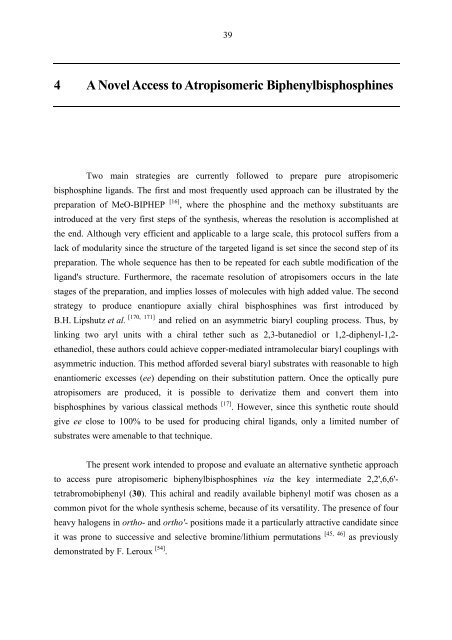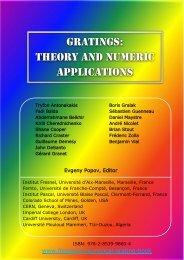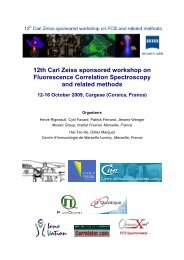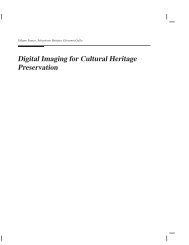My PhD dissertation - Institut Fresnel
My PhD dissertation - Institut Fresnel
My PhD dissertation - Institut Fresnel
Create successful ePaper yourself
Turn your PDF publications into a flip-book with our unique Google optimized e-Paper software.
39<br />
4 A Novel Access to Atropisomeric Biphenylbisphosphines<br />
Two main strategies are currently followed to prepare pure atropisomeric<br />
bisphosphine ligands. The first and most frequently used approach can be illustrated by the<br />
preparation of MeO-BIPHEP [16] , where the phosphine and the methoxy substituants are<br />
introduced at the very first steps of the synthesis, whereas the resolution is accomplished at<br />
the end. Although very efficient and applicable to a large scale, this protocol suffers from a<br />
lack of modularity since the structure of the targeted ligand is set since the second step of its<br />
preparation. The whole sequence has then to be repeated for each subtle modification of the<br />
ligand's structure. Furthermore, the racemate resolution of atropisomers occurs in the late<br />
stages of the preparation, and implies losses of molecules with high added value. The second<br />
strategy to produce enantiopure axially chiral bisphosphines was first introduced by<br />
[ , ]<br />
B.H. Lipshutz et al. 170 171 and relied on an asymmetric biaryl coupling process. Thus, by<br />
linking two aryl units with a chiral tether such as 2,3-butanediol or 1,2-diphenyl-1,2ethanediol,<br />
these authors could achieve copper-mediated intramolecular biaryl couplings with<br />
asymmetric induction. This method afforded several biaryl substrates with reasonable to high<br />
enantiomeric excesses (ee) depending on their substitution pattern. Once the optically pure<br />
atropisomers are produced, it is possible to derivatize them and convert them into<br />
bisphosphines by various classical methods [17] . However, since this synthetic route should<br />
give ee close to 100% to be used for producing chiral ligands, only a limited number of<br />
substrates were amenable to that technique.<br />
The present work intended to propose and evaluate an alternative synthetic approach<br />
to access pure atropisomeric biphenylbisphosphines via the key intermediate 2,2',6,6'tetrabromobiphenyl<br />
(30). This achiral and readily available biphenyl motif was chosen as a<br />
common pivot for the whole synthesis scheme, because of its versatility. The presence of four<br />
heavy halogens in ortho- and ortho'- positions made it a particularly attractive candidate since<br />
it was prone to successive and selective bromine/lithium permutations [45, 46] as previously<br />
demonstrated by F. Leroux [54] .













